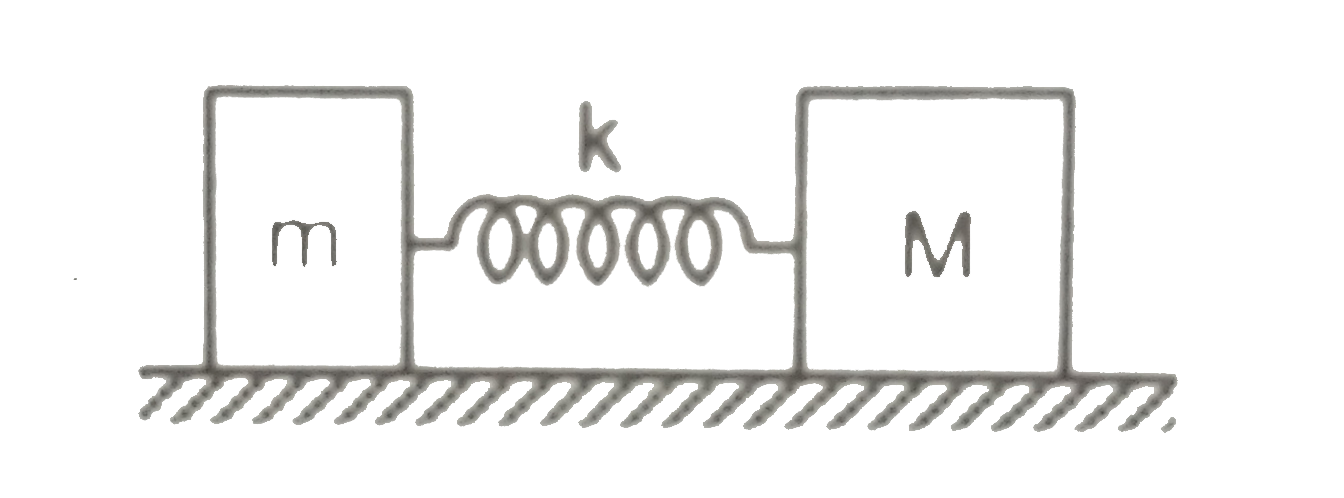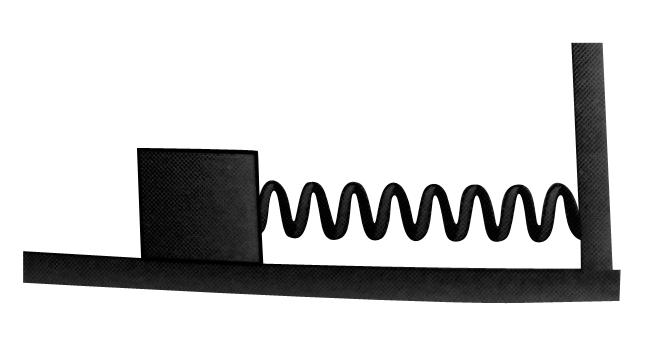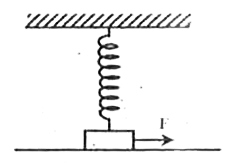An ideal spring is permanently connected between two blocks of masses M and m. The blocks-spring system can move over a smooth horizontal table along a straight line along the length of the spring as shown in Fig.The blocks are brought nearer to compress the spring and then released. In the subsequent motion,

initially they move in opposite directions with velocities inversely proportional to their masses
the ratio of their velocities remains constant
linear momentum and energy of the system remain conserved
the two blocks will Oscillate about their centre of mass which remains stationary
The correct Answer is:A, B, C, D
Since the system of two blocks and a spring is placed on as smooth horizontal floor, therefore no external horizontal force acts on the system.
Since the system is initially at rest, therefore centre of mass of the system will remain stationary and the block will oscillate with the same frequency. it means option d is correct.
Since the system is initially ast rest and centre of mass stationary, therefore centre of mas cannot move or the momentum of the system remains equal to zero. it means, moment of two blocks are numerically equal but they are in opposite directions. therefore, ratio of magnitude of velocity of the two blocks will be in inverse ratio of their masses. Hence, option a is correct.
Since ratio of mass is constant. therefore the ratio of their velocity remain constant. it means that option b is also correct.
Since the system is on smooth horizontal floor, therefore no energy loss takes place. hence, linear momentum and energy of the system remain conserved. therefore, option c is also correct.
Topper's Solved these Questions
- BOOK - CENGAGE PHYSICS ENGLISHCHAPTER - CENTRE OF MASSEXERCISE - Assertion - Reasoning2videos
CENTRE OF MASS
- BOOK - CENGAGE PHYSICS ENGLISHCHAPTER - CENTRE OF MASSEXERCISE - Linked Comprehension105videos
CENTRE OF MASS
- BOOK - CENGAGE PHYSICS ENGLISHCHAPTER - CENTRE OF MASSEXERCISE - Single Correct141videos
CENTRE OF MASS
- BOOK - CENGAGE PHYSICS ENGLISHCHAPTER - CALORIMETRYEXERCISE - Solved Example13videos
CALORIMETRY
- BOOK - CENGAGE PHYSICS ENGLISHCHAPTER - DIMENSIONS & MEASUREMENTEXERCISE - Integer2videos
DIMENSIONS & MEASUREMENT
Similar Questions
Two blocks of masses m and M connected by a light spring of stiffness k, are kept on a smooth horizontal surface as shown in figure. What should be the initial compression of the spring so that the system will be about to break off the surface, after releasing the block m1?
View SolutionA block attached with an ideal spring is kept on a smooth horizontal surface. Now the free end of the spring is pulled with a constant velocity u horizontally. Then the maximum energy stored in the spring and bock system during subsequent motion is :
 View Solution
View SolutionA light spring of spring constant k is kept compressed between two blocks of masses m and M on a smooth horizontal surface. When released, the blocks acquire velocities in opposite directions. The spring loses contact with the blocks when it acquires natural length. If the spring was initially compressed through a distance d find the final speeds of the two blocks.
 View Solution
View SolutionA block of mass m moving with velocity v0 on a smooth horizontal surface hits the spring of constant k as shown. The maximum compression in spring is
 View Solution
View Solution
An ideal spring is compressed and placed horizontally between a vertical fixed wall and a block free to slide over a smooth horizontal table to as shown in the figure. The system is released from rest. The graph which represents the relation between the magnitude of acceleration a of the block and the distance x travelled by it (as long as the spring is compressed) isView Solution
An ideal spring is compressed and placed horizontally between a vertical fixed wall and a block free to slide over a smooth horizontal table to as shown in the figure. The system is released from rest. The graph which represents the relation between the magnitude of acceleration a of the block and the distance x travelled by it (as long as the spring is compressed) isView SolutionA spring is attached with a block of mass m and a fixed horizontal roof as shown. The block is lying on a smooth horizontal table and initially the spring is vertical and unstretched. Natural length of spring is 3l0. A constant horizontal force F is applied on the block so that block moves in the direction of force. When length of the spring becomes 5l0, block leaves contact with the table. Find the constant force F, if initial and final velocity of block is zero.
 View Solution
View SolutionA block of mass m having a charge q is placed on a smooth horizontal table and is connected to a wall through an unstressed spring of spring constant k as shown in figure(29.E1) . A horizontal electric field E parallel to the spring is switched on. Find the amplitude of the resulting SHM of the block.
 View Solution
View SolutionTwo blocks of masses m and m' are connected by a light spring on a horizontal frictionless table . The spring is compressed and then released . Find the ratio of acceleration of masses .
View SolutionA spring is connected between two blocks as shown in the diagram. Initially the blocks are held stationary and suddenly they are released. Find the ratio of maximum kinetic energy with spring compressed the block of mass m to that of mass 2m.
 View Solution
View Solution

